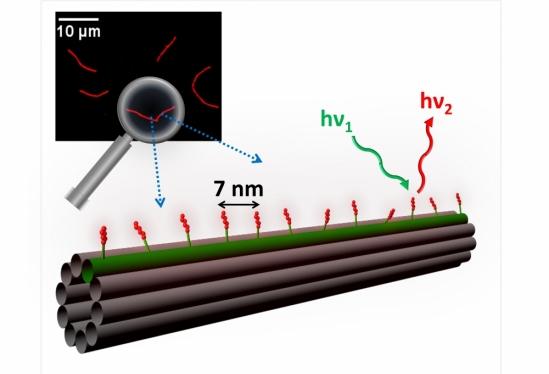A silver lining

DNA controls the size, shape and fluorescent color of the silver clusters themselves. Credit: UCSB
The silver used by Beth Gwinn's research group at UC Santa Barbara has value far beyond its worth as a commodity, even though it's used in very small amounts.
The group works with the precious metal to create nanoscale silver clusters with unique fluorescent properties. These properties are important for a variety of sensing applications including biomedical imaging.
The team's latest research is published in a featured article in this month's issue of ACS Nano, a journal of the American Chemical Society. The scientists positioned silver clusters at programmed sites on a nanoscale breadboard, a construction base for prototyping of photonics and electronics. “Our 'breadboard' is a DNA nanotube with spaces programmed 7 nanometers apart,” said lead author Stacy Copp, a graduate student in UCSB's Department of Physics.
“Due to the strong interactions between DNA and metal atoms, it's quite challenging to design DNA breadboards that keep their desired structure when these new interactions are introduced,” said Gwinn, a professor in UCSB's Department of Physics. “Stacy's work has shown that not only can the breadboard keep its shape when silver clusters are present, it can also position arrays of many hundreds of clusters containing identical numbers of silver atoms — a remarkable degree of control that is promising for realizing new types of nanoscale photonics.”
The results of this novel form of DNA nanotechnology address the difficulty of achieving uniform particle sizes and shapes. “In order to make photonic arrays using a self-assembly process, you have to be able to program the positions of the clusters you are putting on the array,” Copp explained. “This paper is the first demonstration of this for silver clusters.”
The colors of the clusters are largely determined by the DNA sequence that wraps around them and controls their size. To create a positionable silver cluster with DNA-programmed color, the researchers engineered a piece of DNA with two parts: one that wraps around the cluster and the other that attaches to the DNA nanotube. “Sticking out of the nanotube are short DNA strands that act as docking stations for the silver clusters' host strands,” Copp explained.
The research group's team of graduate and undergraduate researchers is able to tune the silver clusters to fluoresce in a wide range of colors, from blue-green all the way to the infrared — an important achievement because tissues have windows of high transparency in the infrared. According to Copp, biologists are always looking for better dye molecules or other infrared-emitting objects to use for imaging through a tissue.
“People are already using similar silver cluster technologies to sense mercury ions, small pieces of DNA that are important for human diseases, and a number of other biochemical molecules,” Copp said. “But there's a lot more you can learn by putting the silver clusters on a breadboard instead of doing experiments in a test tube. You get more information if you can see an array of different molecules all at the same time.”
The modular design presented in this research means that its step-by-step process can be easily generalized to silver clusters of different sizes and to many types of DNA scaffolds. The paper walks readers through the process of creating the DNA that stabilizes silver clusters. This newly outlined protocol offers investigators a new degree of control and flexibility in the rapidly expanding field of nanophotonics.
The overarching theme of Copp's research is to understand how DNA controls the size and shape of the silver clusters themselves and then figure out how to use the fact that these silver clusters are stabilized by DNA in order to build nanoscale arrays.
“It's challenging because we don't really understand the interactions between silver and DNA just by itself,” Copp said. “So part of what I've been doing is using big datasets to create a bank of working sequences that we've published so other scientists can use them. We want to give researchers tools to design these types of structures intelligently instead of just having to guess.”
The paper's acknowledgements include a dedication to “those students who lost their lives in the Isla Vista tragedy and to the courage of the first responders, whose selfless actions saved many lives.”
Media Contact
All latest news from the category: Information Technology
Here you can find a summary of innovations in the fields of information and data processing and up-to-date developments on IT equipment and hardware.
This area covers topics such as IT services, IT architectures, IT management and telecommunications.
Newest articles

NASA: Mystery of life’s handedness deepens
The mystery of why life uses molecules with specific orientations has deepened with a NASA-funded discovery that RNA — a key molecule thought to have potentially held the instructions for…

What are the effects of historic lithium mining on water quality?
Study reveals low levels of common contaminants but high levels of other elements in waters associated with an abandoned lithium mine. Lithium ore and mining waste from a historic lithium…

Quantum-inspired design boosts efficiency of heat-to-electricity conversion
Rice engineers take unconventional route to improving thermophotovoltaic systems. Researchers at Rice University have found a new way to improve a key element of thermophotovoltaic (TPV) systems, which convert heat…



